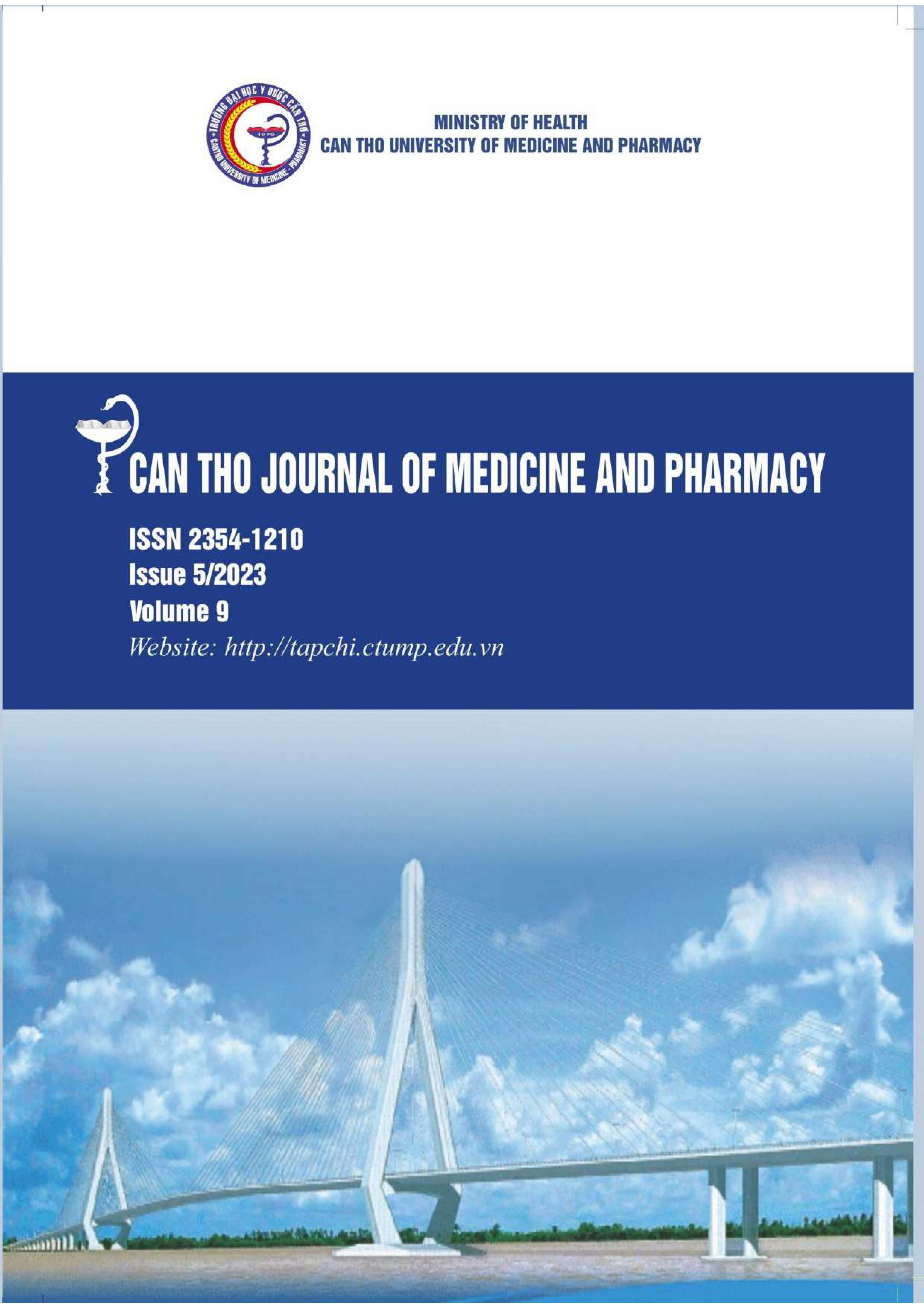ROBOTIC TRANSTHORACIC ESOPHAGECTOMY VERSUS THORACOSCOPIC ESOPHAGECTOMY IN COMBINED WITH LAPAROSCOPY FOR ESOPHAGEAL CANCER
Nội dung chính của bài viết
Tóm tắt
Background: Extended mediastinal with bilateral recurrent laryngeal nerves (RLNs) lymph node dissection (LND) is critical to curative surgery in the treatment of esophageal squamous cell carcinoma (ESCC). Some reports in Robotic transthoracic esophagectomy (RTE) have some advantages over Thoracoscopic esophagectomy (TE) in increasing the exposure and accuracy of mediastinal LND. However, published data was still limited. Objectives: To evaluate early results of RTE combined with laparoscopy to treat ESCC. Methods: This was a prospective nonrandomized comparative study. All patients who underwent RTE or TE for esophageal squamous cell carcinoma were included in the study. The primary endpoints were operation results, morbidity, and mortality. The secondary endpoint was early oncological results, including lymph node harvested, lymph node metastasis, short-term local recurrence, and survival time. Results: From 8/2018 - 8/2020, at Cho Ray Hospital, we performed 109 cases of esophagectomy for esophageal SCC, of which 19 cases (17.4%) were RTE (group 1), and the other 90 cases (82.6%) were TE (group 2). There was no statistical difference in the staging of group 1 compared to group 2, with predominant cases at stages IB, IIA, and IIB (68.5% vs. 54.4%). Group 1 had a longer operation time than group 2 at the thoracic phase (480 (420-540) vs. 410 (380-450), p=0.001, Mann-Whitney test). Left LRN exposure was better in the RTE group than the TE group; however, LRN injuries seemed to be increased with the RTE group (p=0.028 Fisher’s exact test), probably due to the short learning curve. There was also no difference in the number of mediastinal lymph nodes harvested, including lymph nodes along bilateral LRN. Conclusion: RTE combined with laparoscopy is feasible, safe, and effective in treating esophageal SCC. RTE could be a good option in transthoracic esophagectomy for ESCC.
Chi tiết bài viết
Từ khóa
robotic transthoracic esophagectomy, thoracoscopic esophagectomy
Tài liệu tham khảo
2. Chao Y.K., Hsieh M.J., Liu Y.H., Liu H.P. (2018), "Lymph Node Evaluation in Robot-Assisted Versus Video-Assisted Thoracoscopic Esophagectomy for Esophageal Squamous Cell Carcinoma: A Propensity-Matched Analysis", World J Surg, 42(2), pp. 590-598.
3. Fujita H., Kakegawa T., Yamana H., Shima I., Toh Y.(1995), "Mortality and morbidity rates, postoperative course, quality of life, and prognosis after extended radical lymphadenectomy for esophageal cancer. Comparison of three-field lymphadenectomy with two-field lymphadenectomy", Ann Surg, 222(5), pp. 654-62.
4. Hillegersberg R., Boone J., Draaisma W.A., Broeders I.A., Giezeman M.J., et al.(2006), "First experience with robot-assisted thoracoscopic esophagolymphadenectomy for esophageal cancer", Surg Endosc, 20(9), pp. 1435-9.
5. Isono K., Sato H., and Nakayama K.(2019), "Results of a nationwide study on the three-field lymph node dissection of esophageal cancer", Oncology, 48(5), pp. 411-20.
6. Mayanagi S., Irino T., Kawakubo H., Kitagawa Y.(2019), "Neoadjuvant treatment strategy for locally advanced thoracic esophageal cancer", Ann Gastroenterol Surg, 3(3), pp. 269-275.
7. Merritt R.E., Kneuertz P.J., D'Souza D.M., Perry K.A.(2019), "Total laparoscopic and thoracoscopic Ivor Lewis esophagectomy after neoadjuvant Chemoradiation with minimal overall and anastomotic complications", J Cardiothorac Surg, 14(1), pp. 123.
8. Murakami M., Otsuka K., Goto S., Ariyoshi T., Yamashita T., et al.(2017), "Thoracoscopic and hand assisted laparoscopic esophagectomy with radical lymph node dissection for esophageal squamous cell carcinoma in the left lateral decubitus position: a single center retrospective analysis of 654 patients". BMC Cancer, 17(1), pp. 748.
9. Park S.Y., Kim D.J., Kang D.R., Haam S.J., "Learning curve for robotic esophagectomy and dissection of bilateral recurrent laryngeal nerve nodes for esophageal cancer", Dis Esophagus, 30(12), pp. 1-9.
10. Park S.Y., Kim D.J., Yu W.S., Jung H.S.(2016), "Robot-assisted thoracoscopic esophagectomy with extensive mediastinal lymphadenectomy: experience with 114 consecutive patients with intrathoracic esophageal cancer", Dis Esophagus, 29(4), pp. 326-32.
11. Park S., Hwang Y., Lee H.J., Park I.K., Kim Y.T., et al.(2016), "Comparison of robot-assisted esophagectomy and thoracoscopic esophagectomy in esophageal squamous cell carcinoma". J Thorac Dis, 8(10), pp. 2853-2861.
12. Puntambekar S., Kenawadekar R., Kumar S., Joshi S., Agarwal G., et al.(2015), "Robotic transthoracic esophagectomy", BMC Surg, 15, pp. 47
13. Somashekhar S.P. and Jaka R.C.(2017), "Total (Transthoracic and Transabdominal) Robotic Radical Three-Stage Esophagectomy-Initial Indian Experience", Indian J Surg, 79(5), pp. 412417.
14. Tran Phung Dung Tien, Viet Lam Trung, Tran Vu Duc, Nguyen Thi Minh Hue, Nguyen Minh Hai (2011), "Lapthoracoscopic esophagectomy in treatment of esophageal cancer at middle and lower third of esophagus", Ho Chi Minh City Journal of Medicine, 15, pp. 14-19.
15. Zhang H., Chen L., Wang Z., Zheng Y., Geng Y., et al.(2018), "The Learning Curve for Robotic McKeown Esophagectomy in Patients With Esophageal Cancer", Ann Thorac Surg, 105(4). pp. 1024-1030.


